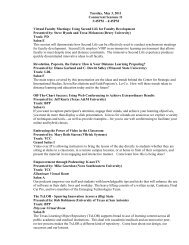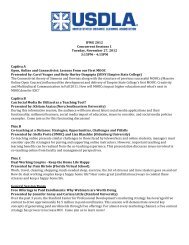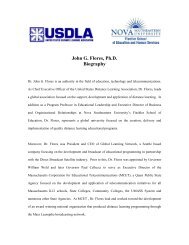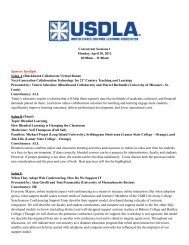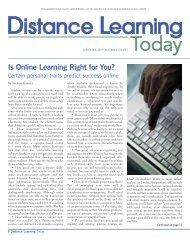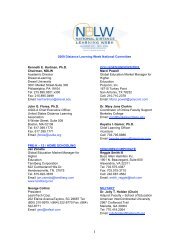United States Distance Learning Association
United States Distance Learning Association
United States Distance Learning Association
- No tags were found...
Create successful ePaper yourself
Turn your PDF publications into a flip-book with our unique Google optimized e-Paper software.
force development, and policy revision<br />
(see Figure 2).<br />
RECOMMENDATIONS FROM<br />
CASE STUDIES<br />
When people within an organization plan<br />
to use distance training and education,<br />
there are several barriers to their efforts<br />
that they are likely to encounter. Consideration<br />
of barriers faced by other organizations<br />
may help leaders find solutions to<br />
reduce or to minimize obstacles in their<br />
own organization. Using a content analysis<br />
of 32 in-depth case studies of leading organizations,<br />
Cho and Berge (2002) explored<br />
solutions to the barriers faced by organizations<br />
when they use distance education<br />
In a traditional, in-person training situation,<br />
registration for the course, documentation,<br />
payment, and travel arrangements<br />
(if any)—all the functions that are normally<br />
thought of as involving the organization—are<br />
completed, for the most part,<br />
before classes begin. Once instruction<br />
starts, the direct interactions that learners<br />
have with their instructors become paramount.<br />
This may not be the case in the distance<br />
training and education classroom.<br />
Opinions from learners in distance education<br />
classes indicate a halo effect as they<br />
suggest that they attribute responsibility<br />
for a much broader scope of barriers to the<br />
instructor compared to what they would<br />
in a traditional setting. For instance, the<br />
organization’s communication infrastructure<br />
is generally not under the direct control<br />
of the instructor, yet such operability<br />
issues as access, network stability, and<br />
technical support are an inseparable part<br />
of elearning. Thus, often learners do not<br />
make as clear a distinction between issues<br />
normally under the responsibility of the<br />
organization from those under the instructors’<br />
control (Keast, 1997; Moore, 1994).<br />
Administrative structure and organizational<br />
change are important issues that<br />
need to be considered simultaneously. Several<br />
of the case studies examined by Cho<br />
and Berge (2002) indicate the primary<br />
importance of organizational culture or<br />
norms, paired with administrative structure,<br />
when an organization implements, or<br />
plans to implement distance training<br />
(Berge, 2001b; Bunn, 2001; Crow &<br />
Rariden, 1993; Keast, 1997; Moore, 1997;<br />
Olcott & Wright, 1995; Shrivastava &<br />
Souder, 1987). Technical infrastructure and<br />
technical support are also closely linked<br />
with other barriers such as user access, student<br />
support, social interaction, and quality<br />
of learning. It appears that when there<br />
is strong support from upper management,<br />
aligned with organizational norms<br />
and culture favorable to DE, other barriers<br />
will be minimized or reduced in intensity<br />
(see Table 5 and Appendix B).<br />
CONCLUSIONS<br />
Technology is one major factor that is helping<br />
to drastically change the world economy.<br />
Changes in society and the<br />
marketplace demand changes in the workplace<br />
that include a shift in the focus of distance<br />
training and education from<br />
instructing to learning. The need for a flexible,<br />
knowledgeable workforce, capable of<br />
making many decisions that are consistent<br />
with management's objectives is driving a<br />
new intensity in the area of talent management.<br />
<strong>Distance</strong> training requires a great deal of<br />
organizational support if it is to be moved<br />
to center-stage and become part of the profile<br />
of the enterprise. This will only occur<br />
as a result of a cultural shift from valuing<br />
education/training to valuing learning and<br />
strategic planning that requires commitment<br />
from the top echelon of the organization.<br />
To make that kind of investment in<br />
time, resources, and effort, there must be<br />
mission critical business needs that are<br />
being address by distance learning (Kearney<br />
& Ottley, 2002). To develop enterprisewide<br />
capabilities for sustaining distance<br />
training and education, it takes continuous<br />
effort to link project management, pro-<br />
8 <strong>Distance</strong> <strong>Learning</strong> Volume 4, Issue 4





